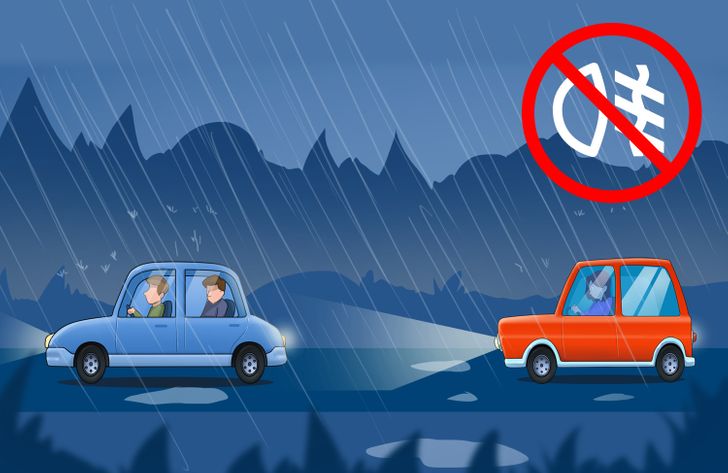If you think a tenth of an inch of rain won’t affect your driving, then you may be surprised to discover how much even a little bit of precipitation can change a road’s condition.
We’ll share why you should drive more mindfully in adverse weather, as well as how to drive safely in the rain and other conditions. In addition, we’ll include guidance on what to do if you start to skid, how to prevent hydroplaning, and how to take care of your car so it can handle poor driving conditions and give you a better chance of maintaining control.
The Dangers of Driving in Bad Weather
Dry roads provide the optimal driving conditions where your tires connect to the roadway and give you maximum control. Also, in ideal conditions, you can see ahead and make adjustments in your driving, depending on what you see. In stormy conditions, you may not be able to see or control your vehicle as easily especially if you’re driving an RV.
The Risks of Wet Roads
Your car’s tire tread is designed to move water. If you’ve ever looked at racing tires, you’ll notice that they’re smooth. They provide a race car with the ideal design to win a race.
But if you’re a Formula 1 fanatic, you probably noticed that if it is raining or has recently rained the track is wet, the races are canceled. That’s because those no-tread tires can’t move water and hydroplane easily.
Hydroplaning is the most severe risk of wet roads. And if your tires are bald or the tread is worn, they won’t be able to move water effectively. When you hydroplane, you have no control over the vehicle. Then, when your tires contact the road again, you’ll feel the effect of any overcorrections you tried while you were hydroplaning.
It takes longer to stop on wet roads. The amount of water on the road and the condition of your tires make a difference in how much the stopping distance increases.
The Poor Visibility While Driving in Snow and Fog
Some of the most frustrating conditions to drive in are snow and fog. If you can’t see where you’re going, you risk overdriving your sight and crashing into obstacles on the roadway.
If the visibility is 100 feet, you’ll be unable to see beyond that, and if you can’t stop within 100 feet, you’ll likely crash into cars stopped in the roadway or be forced to drive off the road to avoid those obstacles.
The Slippery Nature of Winter Precipitation
While wet roads decrease your ability to maintain control and increase your stopping distance, icy roads are even worse. For example, if you need 100 feet to stop on dry roads, you could need 600 to 1,000 feet to stop on icy roads.
How to Drive in Adverse Weather Conditions
How you handle adverse weather conditions while you’re driving can make the difference between staying safe and causing a crash.
Don’t Drive on Bad Roads Unless You Must
If you can stay home, stay home. If you’re running errands that can wait until later in the day or tomorrow, consider putting off your plans when the conditions are better. If you can order things online instead of driving, do that. You can order anything from groceries to clothes to flowers online and probably do it frequently. So don’t go out unless you must.
Don’t Be in a Rush in Adverse Weather
Taking your time driving in adverse weather conditions is one of the best ways to ensure your safety, but when you leave late for an appointment, you may be tempted to drive more aggressively than you should.
Leaving early will help reduce your stress and will give you time to respond to the conditions and hazards.
Leave Plenty of Following Distance in Poor Conditions
Since bad weather conditions make it harder to maneuver your car, be sure to leave an adequate following distance between you and the vehicles ahead of you. If one of them spins out or crashes, you need to give yourself the space to react safely and avoid getting involved in a crash.
Start Stopping Early on Snowy, Icy, and Wet Roads
Since your stopping distance could be doubled on wet roads and increased up to 10 times on icy roads, don’t expect to stop like you would in normal conditions. For example, if you usually start slowing down 60 feet before a stop sign, start slowing down at least 120 feet before the stop sign in poor conditions.
Maintaining Your Car for Better Safety
Your car is your tool for getting around, and the better suited it is for adverse conditions, the better you’ll be able to maintain control.
Take Care of Your Tires
Your tires are the single most crucial aspect of your vehicle when it comes to bad roads. Tires suited for the weather will keep you in the best control. If you live in a region where you have long winters, you should consider purchasing winter tires.
The rubber is softer, so they can maintain traction with the road more effectively than all-season tires, whose rubber becomes more rigid in cold temperatures.
Instead of having a set of summer tires and winter tires, you might consider purchasing one set of four-season tires. These are not the same as all-season tires. Instead, four-season tires have a snowflake symbol on them, and that indicates that they have gone through and passed winter driving testing.
In addition to the type of tire you have, you should also check the condition of your tires. If the tread is worn, you’ll need to get new tires. Regular rotations can help you extend the life of your tires and ensure they wear evenly.
Address Vehicle Problems
If you notice a dash light for your vehicle stability control, anti lock brakes, or traction control, get the problem checked out by a reputable mechanic as soon as possible. These safety features help you maintain control in adverse conditions, so you need to ensure they’re in proper working order.
Use the Right Fluids
You might not think that your windshield wiper fluid would make a difference in your safety, but if you use fluid rated for 20 degrees and it’s 10 degrees outside, your fluid will freeze, and you won’t be able to clean your windshield while you’re driving. This inability to clean your windshield could decrease your visibility and contribute to unsafe driving conditions.
You should also make sure you use winter fuel or additives if you’re driving a diesel vehicle in frigid weather, or you could experience gelled fuel lines.
Review Your Insurance Policy
Reviewing your insurance policy won’t make you a safer driver, but it can help you recover from the financial impact of a crash. Nearly every state requires liability insurance, but unless you have a loan for your vehicle, you have the option to carry or drop full coverage.
Keep in mind that if you cause a crash and don’t have collision coverage, you’ll be responsible for the repairs or replacement of your vehicle. So, before you drive in bad conditions, consider if you have full coverage insurance, and if not, if you’re willing to take the risk of crashing your car and paying for the damages out-of-pocket.
By taking care of your vehicle and leaving plenty of time to get where you’re going, you can drastically reduce your likelihood of being involved in a weather-related crash. So, get your car checked out before winter, make sure your tires are appropriate and drive carefully to keep yourself safe.
Melanie Musson writes and researches for the auto insurance comparison site, AutoInsurance.org. She’s passionate about helping others understand their insurance needs and find the best policy to protect their investment in their vehicle and their financial stability.







